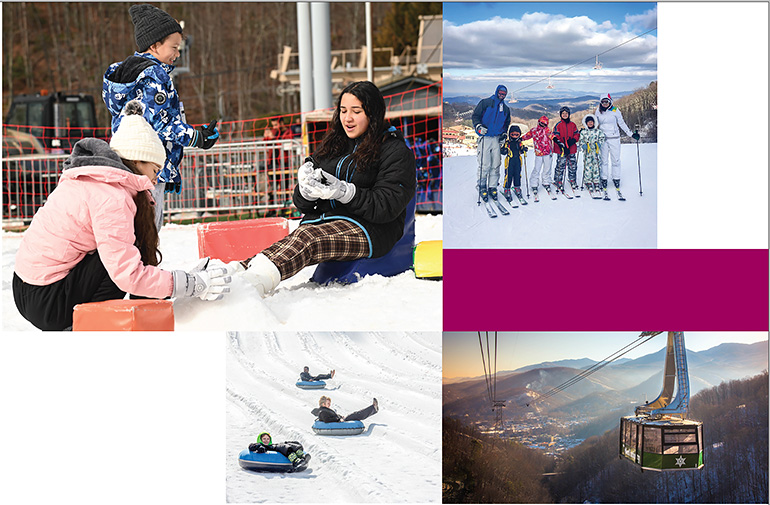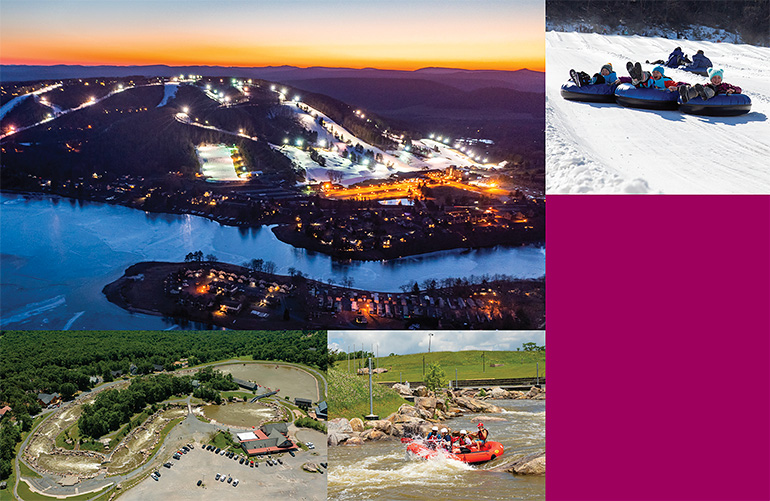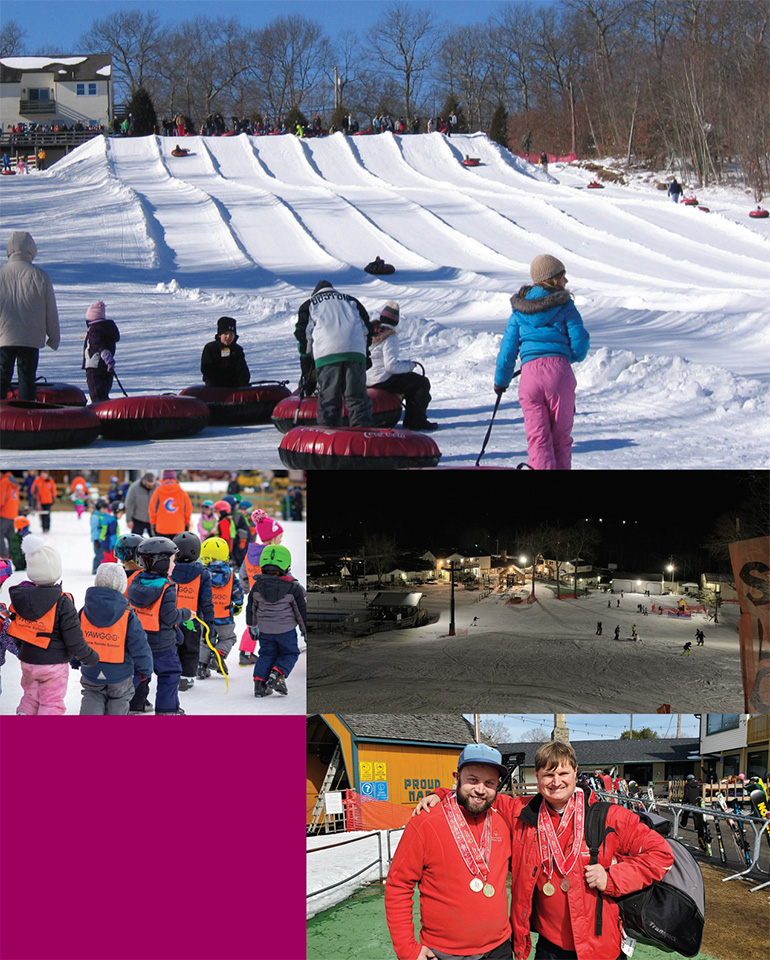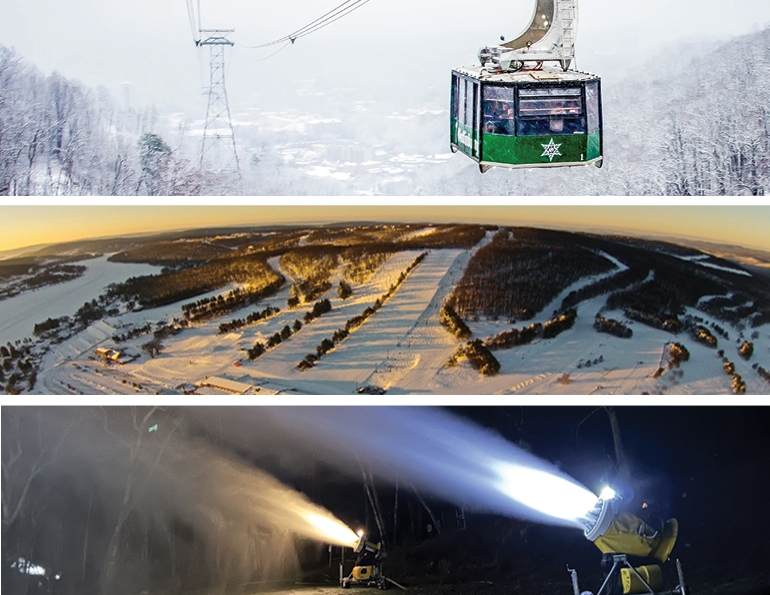While some states are dense with ski areas, Tennessee, Maryland, and Rhode Island boast only one ski area each. These “onlys” play pivotal roles in the snowsports industry and the recreation economies of their respective regions. Here, we’ll take a closer look at these unique operations, their challenges and triumphs, and their place in the market.
OBER MOUNTAIN: ROCKY-TOP ATTRACTION
Tourism is the engine that drives Gatlinburg, home of Tennessee’s only currently operating ski area, Ober Mountain (formerly Ober Gatlinburg). “If you’re from here, tourism—particularly in the summer—was a part of your life,” says John Baker, the new owner of the ski area-cum-amusement park just outside Great Smoky Mountains National Park.
Baker and his team are new to the snowsports industry, but he feels their history and dedication to the Gatlinburg region will guide them to help Ober evolve and grow. “My family has lived here for more than 200 years and for much of that, tourism has always been part of our family story,” he says.
When it comes to running a ski area, “We have so much to learn,” Baker says. “I think my best talent is knowing I don’t know all the answers.” Good news for Baker, longtime owners the Anders family, who sold the ski area and its myriad other attractions in October 2022, are not going anywhere: former resort president Kent Anders is currently consulting for the mountain.
 Clockwise, from top left: Ober’s popular snow-play area is covered year-round; a new rental package at Ober will include soft goods; the iconic Ober tram is a major four-season draw; winter activities, like tubing, are novel to the Ober crowd.
Clockwise, from top left: Ober’s popular snow-play area is covered year-round; a new rental package at Ober will include soft goods; the iconic Ober tram is a major four-season draw; winter activities, like tubing, are novel to the Ober crowd.
Understanding the Guest
Anders says that Ober’s strength comes in understanding its client: Mostly one and done visitors, sometimes looking for an experience as simple as just seeing snow for the first time.
“Skiing and winter sports as a whole are a novelty here,” says Anders. “And with 75 to 80 percent of our visitors being non-skiers, you’ve got to offer them something good.” Millions of visitors stream through Gatlinburg and nearby Pigeon Forge into Great Smoky Mountains National Park each year, and there are dozens of other attractions vying for their dollars.
The iconic Ober tram is a major draw. Year-round snow is another. “We have a lot of visitors who have never seen snow before,” says Baker.
One of Ober’s biggest successes is a giant outdoor snow-play area, visible from the base lodge. For $10 a head, guests can slide, have snowball fights, make snow angels, and just play in piles of frozen fun. It’s so successful, Ober has doubled the size of the area.
It’s covered year-round by a Snow Magic all-weather snowmaking system. Development plans include adding two more of the systems to bolster and further expand the area.
As for the skiing itself, “We see our position in the industry as a beginner area,” says Anders. The new owners, he says, are embracing that by creating a full rental package that includes equipment and soft goods (jacket, pants, etc.), making the introduction to skiing/riding easier and, they hope, more affordable.
Updates and Additions
Looking ahead, Baker and his team have plans to refresh Ober’s infrastructure and expand on its already extensive list of offerings.
The first priority, says Baker, is to upgrade the mountain’s snowmaking system, an effort already in motion. Eight automated SMI Super Polecats were added ahead of the 2022-23 season, and 40 more will be added before next season. These new guns will allow Ober to respond to short windows of snowmaking conditions—vital for its southern location—and make more snow in less time using much less power and water than it currently does.
Baker also plans to increase snowmaking water retention for the 2024-25 season (Ober ran out of water at one point last season) by expanding two of its five snowmaking reservoirs to increase water storage capacity.
Lifts are next, with the goal of replacing those in need and servicing those that can remain. (Ober has 10 trails and one terrain park spread across 38 skiable acres with 600 feet of vertical served by five aerial lifts and two carpets.)
As for new activities, one of the few things the Gatlinburg area doesn’t have is lift-served downhill mountain biking. That’s going to change. Baker has already had trails designed and building is underway for the new bike park to debut this summer.
While Gatlinburg isn’t just a ski area, being the only ski resort in the state is a positive, says Baker. “There’s a lot about it that’s cool,” he explains. “People who don’t know about skiing discover it here, and that’s meaningful in itself.”
WISP RESORT: FOUR-SEASON DESTINATION
Long ago, when the policy wonks, government employees, and elected leaders of the greater Washington, D.C., area needed to escape, they hopped a train from the city and chugged 180 miles northwest to the Oakland station in Maryland’s Garret County, where the fresh air and beauty of Marsh Mountain and Deep Creek Lake offered them a reprieve from city life.
In some ways, nothing has changed since then. That region, now home of PGRI-owned Wisp Resort, Maryland’s only active ski area, remains a mecca for those from D.C. and Baltimore seeking a ski or summer escape close to home. In fact, 80 percent of the resort’s business comes from the two cities.
Families First
Historically, at least 10 other ski areas have tried to operate in Maryland, and only Wisp remains. What’s the secret to Wisp’s enduring success where others have failed?
General manager Ron Hawkes believes it is a combination of proximity to those metro areas, Wisp’s mountainous, rural location, and the resort’s attributes. The mountain has 30 trails spread across 170 skiable acres with 700 feet of vertical, and it skis bigger than those modest stats would suggest. Its location next to Deep Creek Lake adds to its draw as a prime destination in both summer and winter.
 Clockwise, from top left: Wisp is “a true resort” with ample lodging and night skiing for overnight guests to enjoy; family-friendly activities, like tubing, are core to Wisp’s brand; a unique recirculating whitewater course is a draw in the summertime.Plus, Wisp knows it primary audience. “We are families,” Hawkes says. “I just came off the hill and today, like every day, it’s loads and loads of families out there.”
Clockwise, from top left: Wisp is “a true resort” with ample lodging and night skiing for overnight guests to enjoy; family-friendly activities, like tubing, are core to Wisp’s brand; a unique recirculating whitewater course is a draw in the summertime.Plus, Wisp knows it primary audience. “We are families,” Hawkes says. “I just came off the hill and today, like every day, it’s loads and loads of families out there.”
To make it easy for families to vacation at Wisp, the resort has more lodging than most ski areas its size, including a slopeside 169-room hotel and nearly 900 rental homes. Families can—and do—make Wisp their home-base while also exploring the other recreational opportunities in the area that aren’t affiliated with the resort.
Marketing Maryland Mountains
While Maryland is known for its water, Wisp has worked to correct the common misconception that the state doesn’t have mountains. “Annapolis, the Harbor, the water, that’s what Maryland is known for. We’d be kidding ourselves to think anyone would [automatically] think mountains and snow. It’s a matter of getting the word out,” says Hawkes.
To do that, Wisp partners with Maryland Tourism and Garrett County, both of which are motivated to promote winter tourism in the region. These are mutually beneficial relationships. “We don’t look at ourselves as a standalone,” says Hawkes. “They market us, and we market them. There’s no looking to secure our own little niche.”
It’s working. So popular is Wisp, it completely sold out of lodging and lift tickets a dozen times during the 2021-22 winter season.
While that’s great for the bottom line, Hawkes admits that the guest experience on those busy days isn’t what the resort aims to offer. “If GMs were honest with themselves, they’d say there are a handful of days each year when we are not proud of what we are doing,” he says.
Wisp strongly encourages guests to purchase lift tickets in advance to “keep our quality experience and be proud of what we are delivering.”
Four-Seasons of Fun
One thing that bolsters demand: Wisp is “a true resort,” says Hawkes, with the hotel and a variety of dining options, a mountain coaster, Escape Games (an escape room activity), and tubing available in winter.
In the summer, Wisp has disc golf, a zip line and canopy tour, the “only mountaintop recirculating whitewater course in the world” offering whitewater rafting and kayaking at the mountain’s summit, and two 18-hole championship golf courses, among other activities.
And the resort is adding a new $300,000, 18-hole mini golf course. “We’re not holding back,” Hawkes says of the new mini golf track. “It’s the real deal.”
But what’s it like to be the only one in your state?
Hawkes admits it has its challenges, but he sees benefits as well. “When you are the only ski area in a state, unlike New York and Pennsylvania, you don’t have anything like a Maryland Ski Association,” Hawkes says. “But Pennsylvania invites us to educational events, and we are members of NSAA and the Southeast Ski Areas Association, so we find support in those spots.”
And when it comes down to it, says Hawkes, “We are Maryland’s only four-season resort. I cannot emphasize that enough. It’s great, great to be the only one.”
YAWGOO VALLEY: THE LOCALS SPOT
When Yawgoo Valley first opened in 1965, some may have wondered how advisable it was to take a modest hill set close to the ocean—where the water’s temperature tends to turn snow into rain quicker than most areas—in the nation’s smallest state and turn it into a ski area.
If there were any naysayers back then, they stand corrected today, as Yawgoo Valley Ski Area in Exeter, R.I., has stood the test of time through “pure determination,” says general manager Tracy Hartman. “If you don’t have the heart for this industry, you’re just not going to make it.”
Keys to Success
Hartman’s father Max de Wardener has owned the area since 1980. As the only remaining of five ski areas that operated in Rhode Island (which boasts the lowest high-point of any state in New England: 812-foot Jerimoth Hill, which was never a ski area), Yawgoo is indeed surviving, if not thriving. Its popular weekly kids’ ski camp, for example, sells out so quickly that parents plan on being at their screen the moment registration opens each year to ensure their kid(s) get a spot.
Hartman believes the keys to success over the years have been knowing where to make investments and building and keeping a dedicated staff.
“The weather is our biggest challenge,” she says. “We’re near the ocean, so we get more rain if the lows track to the east, more snow if to the west. That’s why snowmaking has to be our first priority. We have to keep updating, and not let things age. Fixing it easily and turning it on when we need to is vital for us.”
The staff may be the ski area’s secret sauce, though. Yawgoo has built a loyal staff that, Hartman says, will do just about anything to help the business succeed. Some staff have been there for 20 to 30 years.
“The staff is why we are still here,” she says. “They’re dedicated. They are our family, and when I say we are family run, I mean not by blood but by choice.
“The short season is a challenge,” Hartman adds. “It’s a strain and a stress. It takes dedication and people have to want to be here. We make that clear; but we also salute them for doing what they do by taking that all on.”
 Clockwise, from the top: A robust tubing operation is key to Yawgoo’s success; night skiing extends opportunities to get on the snow for locals; Yawgoo has hosted the Rhode Island Special Olympics for 25 years; kids programming regularly sells out in winter and summer.
Clockwise, from the top: A robust tubing operation is key to Yawgoo’s success; night skiing extends opportunities to get on the snow for locals; Yawgoo has hosted the Rhode Island Special Olympics for 25 years; kids programming regularly sells out in winter and summer.
Luring Locals
Yawgoo, as a self-positioned “stepping stone” resort, thrives on school groups and learning groups in the winter. “We are primarily family and primarily local,” says Hartman. “I don’t want to say it’s simple, but in a way it is. Kids’ programs sell out really fast. We focus on that.”
The five-week learn to ski/ride program sells out annually, and Yawgoo has six regular school groups all winter. Add passholders and single-day visitors, and that’s enough—Hartman says they’re conscientious about not overcrowding the hill’s 12 trails and 36 skiable acres, which are served by two double chairs and a rope-tow.
Yawgoo has also had a robust tubing operation since it opened in 1995. Tubing is offered in 90-minute sessions Fridays, Saturdays, and Sundays. Guests are encouraged to buy in advance online because sessions sell out often.
Yawgoo doesn’t have a huge marketing budget, nor does it have a ski association to co-market with. As the only ski area in the state, it doesn’t necessarily need to spend big on marketing.
“What happens with us is word of mouth,” Hartman says. “They come and have a good experience and then say ‘wow—Yawgoo is open! I cannot believe they have snow!’ We do our best to help people share that message.”
Otherwise, Facebook, Instagram, and email are its main marketing channels. And local partnerships—like one with Cardi’s Furniture, a strong brand throughout New England—also help the ski area maintain a presence in the market.
In addition, Yawgoo has hosted the Rhode Island Winter Special Olympics for more than 25 years—an important community event.
The Future
While Yawgoo has a strong summer operation—it boasts the only water park in the state, and its kids’ summer camp program also fills up annually—winter is still the breadwinner.
Can it continue with winter as its primary focus given the unreliable weather?
“I am hoping we can keep this a ski area for a long, long time, but I don’t know,” Hartman says. “I think if we adapt a little better, we can.”
She has ideas.
“My son got married at the top of the tubing park hill and it was amazing,” she says. “I’m not saying that because it was my son; it was really lovely. Maybe the direction we will go is weddings.
“I know this: We have to evolve. With the changes in the weather, we just have to.”






